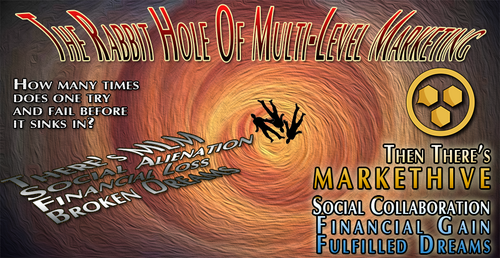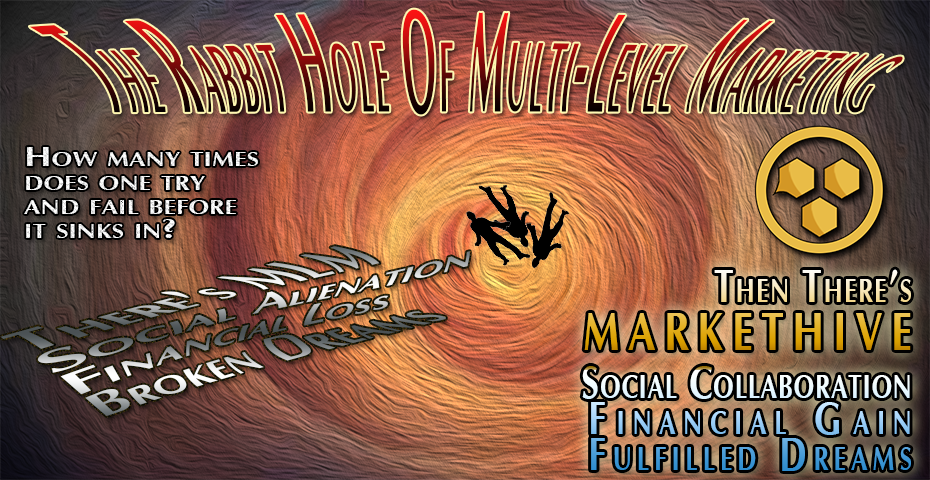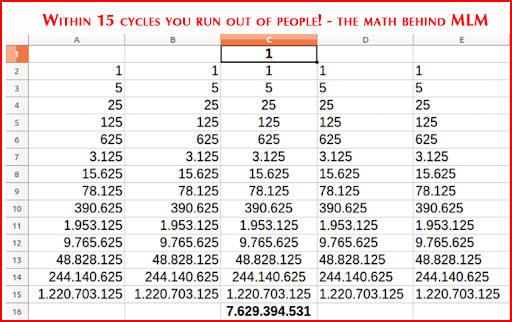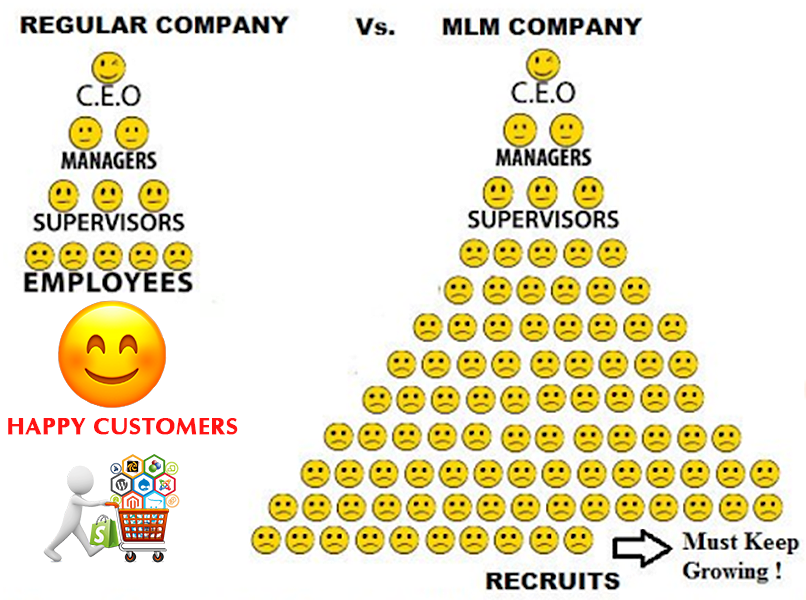


The Multi-Level Marketing Industry has been around for decades starting out with home parties or Party Plan and predominantly seen by women as a way to supplement the family income. MLM companies never advertised on mainstream media, so relied on word of mouth and solicited recruitment of anyone inexperienced or otherwise, and that was all well and good until the hype of fulfilling dreams of getting rich beyond your wildest dreams, firing your boss, becoming your own boss all because of the unsustainable and complicated compensation plans created by the company to entice anyone that would listen.
Over time the MLM industry has evolved online and this is when scams escalated and the promise of untold wealth for doing nothing really became a mindset. Some companies have products albeit a few making outrageous claims about the benefits, but many don't have a product or service or at the very least they portray a facade of digital products that could normally be accessed online for free. The latter has been dubbed a money game showcasing their gimmicky comp plans since the internet era. Fundamentally, if an MLM company pushes recruiting and is only interested in building a team to fill up a matrix in the compensation plan, not focusing on acquiring customers to buy their product, this is considered a pyramid scheme and very much a red flag.
There are programs that have failed, only to pop up later with a new name but similar model sucking in unsuspecting and usually desperate people looking to make an income online, or even worse believe the promise of getting rich quick. There are a number of individuals that keep launching new companies, all with matrix or binary comp plans then eventually closing them, then move on to the next, then another, and people losing money hand over fist with no recourse.

MLMs work by geometric expansion, where you get ten to sponsor ten, to sponsor ten, and so on. This is usually shown as an expanding matrix (looks very much like a "pyramid"!) with corresponding kick-backs at various levels.
The problem here is one of common sense. At a mere three levels deep this would be 1,000 people. At six levels deep, that would be 1 million people believing and expecting to make the amount of money promised to fulfill their dreams of becoming a millionaire. This, of course, must go on ad infinitum. This is proven to be unsustainable, there just wouldn’t be enough people in the world, let alone interested prospects, not to mention the attrition or churn rate of recruits.
I have spoken to individuals who know its limitations and flaws and they just say, “That’s ok, at least I can make some money while it lasts.” What about the poor people that come in after you?
The ethical question is, Are MLMs a morally acceptable way to make money?
There are a few MLM companies that have been around for years that are legitimate as they concentrate on selling the products, some have even done away with their suspect compensation plan to stay in good stead with the Federal Trades Commission. (FTC) Illegal pyramid schemes do have a product, but critics say that many MLMs have a business model that focuses on recruiting “downline” and getting new distributors to buy the product, rather than on actual sales to consumers, making them akin to pyramid schemes.
When you take a look at the FTC, and what they have to say about MLM companies, you need to offer retail products in order to stay in compliance with the law. This can be confusing for some however what it means is a company must have retail products that can be purchased by customers only without them having to become a distributor and buy into the opportunity offered through the comp plan to get those products.
Robert L. FitzPatrick is an expert in examining and revealing deception and fraud in Ponzi schemes, pyramid schemes, and bogus home-based businesses opined,
“MLMs do not have brands in the same way that conventional companies do. Some MLMs have almost no "customers" at all other than their own “distributors” and most of them last less than a year. Arguably, MLM can’t be understood by business analysts because it more closely resembles a cultic religion than a business.
MLM’s “brand” is not based on products or on company culture, customer loyalty, or on new technology or social or political values. The brands of all MLM companies are one and the same, "multi-level marketing" itself, the contradictory business model, involving recruiting your own competitors and “being your own customer.” Each and all require “endless chain” recruiting and they always produce the same outcome: the majority of all “commissions” wind up in the hands of the top 1% of recruiters, kind of like a pyramid scheme always does.”
While this is the most difficult point to make, it is perhaps the most important. Anyone who has any experience with an MLM has strong feelings, either for or against, and this is the problem. Polarization runs deep.
There are a host of issues brought forth regarding multi-level marketing companies, often from former distributors and the disgruntled community is growing. If you search YouTube, you can find countless videos outlining the numerous problems with various MLM companies.
There have been many arguments raised by MLMers.
“How can it be a pyramid scheme if it’s legal?”
Through some crafty loopholes. The fact that there is an actual product to sell allows them to operate and give the appearance of legitimacy. If you need to fill your matrix up to be eligible for commissions, it’s a pyramid scheme.
“You just haven’t found a good MLM yet.”
Wrong. A good MLM is an oxymoron. Multi-level Marketing is the brand. No matter what products they have, if the distributors are forced to recruit, then most are doomed to failure. The biggest problem with MLM’s is that most distributors don’t make a profit. In fact, a majority end up losing money. According to the FTC, an astounding 99% of recruited sellers lose money. From the FTC report: “MLM as a business model is the epitome of an “unfair or deceptive acts or practice”.
“But how is this any different from any other major corporation where the CEO makes the most money?”
Because the people below the CEO at legit companies get paid salaries and have actual benefits. They don’t depend on endless chains of recruiting new members and asking for money upfront.

Jeff Babener, Babener & Associates/MLMLegal.com published a guide explaining the major types of plans. The two outlined below became popular since the advent of computer technology.
This plan looks like a grid in which a distributor is limited to a certain number of recruits at each level. For example, in a 3-by-5 matrix, each level down to five can have only three downline distributors.
This type of plan is sometimes considered to be more gimmicky than others. Why? Because due to the width limitations, new recruits may find themselves placed underneath upline distributors who did not directly recruit them. In a three-wide matrix, for instance, the fourth distributor you personally sponsor would be placed under one of the first three distributors you personally sponsored (your first-level distributors).
Matrix plans have been subjected to attacks by regulatory agencies because they sometimes look like "a game." By and large, they have not had a successful record in the industry, and they foster nonproducers, which makes the upline distributors resentful. Nevertheless, several major companies operate matrix plans.
The binary plan is the newest on the scene. In a binary plan, a distributor is allowed to occupy one or more "business centers," each limited to two downline legs. Compensation is paid on group volume of the downline legs rather than a percentage of sales of multiple levels of distributors. In other words, payment is volume-driven rather than level driven. Sales volume must be balanced in the two legs to be eligible for commissions, which are paid at designated points when target levels of group sales are achieved.
The distributor may occupy multiple positions and may re-enter or loop below the other two leg matrices in which he or she has been active. There is no depth limit on payment but each matrix has a finite amount that can be paid out, thus necessitating involvement in multiple two-leg matrices.
The binary is the most controversial of plans. The binary had its unfortunate origins in the early 1990s in fraudulent gold coin programs, and its use later for other questionable products did not help. Those subsequent products were generally high-ticket one-time purchases such as consumer service or travel memberships, travel certificates, or overpriced prepaid phone cards. By the end of the 1990s, and after many legal challenges, the binary was not in great favor, and only companies like USANA, that had applied the concept to consumables, seemed to be around.
Critics charged that the implementation of binary plans brought on legal and business problems. Companies and distributors tended to promote the plan rather than the product, creating accusations of a "money game." Often plans had a one-time sale requirement which created a something-for-nothing atmosphere and appearance of payment for headhunting recruitment.
The multiple business center approach was often presented as a "purchase of a business center," an "investment," or a "front-load" of product. The ability to stack personal business centers also created the possibility of front-loading. The required balancing of sales volume between legs meant that hard work might yield no payoff and income would be forfeited because personal production did not count if balanced sales volume did not occur.
Finally, the multiple re-entry or looping created a "game-like" atmosphere in which an individual could end up in the downline of someone he or she had sponsored. For the distributor looking long term at a distributorship that might be sold, this "looping" also made it virtually impossible to place a value on a distributorship because no continuous downline genealogy could exist.
An issue in determining the legitimacy of a multilevel marketing company is whether it sells its products primarily to customers or to its distributors who must recruit new members to buy their products. In other words, does it emphasize getting products or services into the hands of consumers, or does it emphasize making money by finding new recruits? If it falls into the latter category, run away, fast. In the end, it’s the product, not the compensation plan that drives success.
Most people that are lured into these companies have little money to invest and want to believe the hype about utopian promises, get rich quick schemes, and how they can achieve great success. How they can fire their boss and be their own boss. Essentially, you are not your own boss. You have no control over the company, its products, people you recruit, or comp plan.
Multi-level marketing companies are not new. However, with the rise of social media, more people are becoming fed up with their tactics. In fact, there is an anti-MLM subreddit devoted to calling out MLM practices and product quality. If you are considering buying a product from or signing up with an MLM opportunity, do your research first.
The idea of investing in a legitimate company at a grassroots or shareholder level was out of the question. Only capital investors or entrepreneurs with millions of dollars were invited or could get involved. Hence the saying “the rich get richer and the poor get poorer”, until now.
Markethive has been created for the rank and file to achieve success on every level. Starting out with the ability to promote your business with all the inbound marketing tools including blogging platforms, email services, CMS, etc, which you would normally have to pay for is free to use at Markethive. Then there is the collaborative social media platform of like-minded individuals which of course is free. It’s free but you get paid to use it!
Huh? How? Blockchain Technology and Markethive’s crypto ecosystem has made this a reality for everyone to attain sovereignty and the freedom to create an income. It’s also the answer to an inequitable marketing industry.
But the icing on the cake is the ability to become a shareholder in Markethive via the Entrepreneur One Loyalty Program for $100 per month. This involves not only your cumulative share of an ILP (Incentivized Loan Program) but a number of cottage businesses that are like your franchises where the earning potential on these genuine products is huge.

The first one being launched at the end of this month is the Banner Impressions Exchange. (BIX) Markethive does all the work, drives the traffic and you sell your share of impressions for the price you set. You keep all the profits from the impressions you sell, for one small flat monthly fee of $100. Now that’s an offer never seen before and allows regular folks like you and me to realize financial success in a real company, not driven by greed or imperialistic status.
Marketers and businesses pay 10 to 20 times more than $100 per month just for the inbound marketing tools mentioned above that you get for free in Markethive!

This is not MLM, this is a real business and social market platform with next-generation technology and provides services that are proven and products with substantiated and provable facts. These are products that are being used all over the internet for the purpose of creating exposure to all businesses and content. This medium is increasing exponentially as more companies choose to advertise online. It’s unfortunate that MLM victims are so accustomed to getting ripped off they find it difficult to determine a genuine company.
The Visionary and Founder of Markethive, Thomas Prendergast explains in this video the conditioned mindset of the many that keep them trapped in the merry go round of living week to week, paycheck to paycheck. He also elaborates on the BIX that will be open for all Entrepreneur One upgrades to trade,
The Entrepreneur One Loyalty Program for $100 per month is limited to 500 with the rollout of the first of many franchises (BIX) expected to launch on May 1st, 2020. After that date, if there are any E1s left they will be available for the purchase of $1,500 per month. Until then, we are calling on people to beta test the exchange.
The Entrepreneur Two, Three, Four, etc, have been taken off the table to focus on the Apprentice and Journeyman subscriptions. More on that soon.
If you’re still thinking about upgrading to E1 to take advantage of the money machines Markethive has in store for you as well as becoming a shareholder, you only have 8 days left at the time of writing this. Don’t be a “shoulda, woulda, coulda”, that can be a costly exercise. You really can be your own boss with the control required to succeed in Markethive making it your primary source of income.
Click this link to upgrade before May 1st. https://markethive.com/upgrademe

Deb Williams
A Crypto/Blockchain enthusiast and a strong advocate for technology, progress, and freedom of speech. I embrace "change" with a passion and my purpose in life is to help people understand, accept, and move forward with enthusiasm to achieve their goals.
